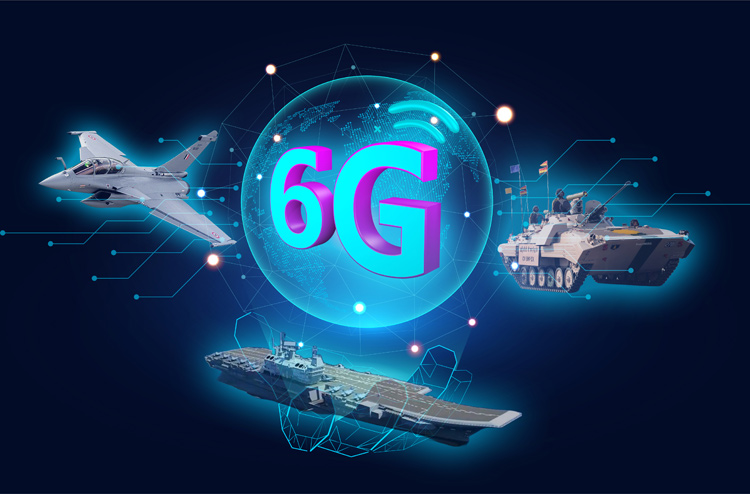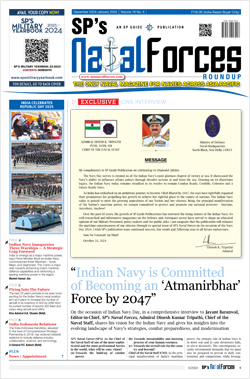INDIAN ARMED FORCES CHIEFS ON OUR RELENTLESS AND FOCUSED PUBLISHING EFFORTS

The insightful articles, inspiring narrations and analytical perspectives presented by the Editorial Team, establish an alluring connect with the reader. My compliments and best wishes to SP Guide Publications.

"Over the past 60 years, the growth of SP Guide Publications has mirrored the rising stature of Indian Navy. Its well-researched and informative magazines on Defence and Aerospace sector have served to shape an educated opinion of our military personnel, policy makers and the public alike. I wish SP's Publication team continued success, fair winds and following seas in all future endeavour!"

Since, its inception in 1964, SP Guide Publications has consistently demonstrated commitment to high-quality journalism in the aerospace and defence sectors, earning a well-deserved reputation as Asia's largest media house in this domain. I wish SP Guide Publications continued success in its pursuit of excellence.
- MoD initiates comprehensive review of Defence Acquisition Procedure 2020, pushes for defence reforms
- G7: The Swansong
- Kalinga Connect: South Asia to Polynesia
- Advanced MRSAM for India for a greater firepower
- Must Credit DRDO for Operation Sindoor, now what is next for defence R&D?
- Operation Sindoor | Day 2 DGMOs Briefing
- Operation Sindoor: Resolute yet Restrained
6G will transform military-industrial applications
Unleashing the future with 6G technology's revolutionary impact on military, geopolitics and cybersecurity

In the world of telecommunications, 5G represents greater speeds, lower latency and greater capacity for data networks. 5G also enables massive machine-type communications and the possibility of implementing virtual networks through network slicing. In the rapidly changing warfare tactics, it is an open debate that the future of combat will be autonomous and reliant on data-driven artificial intelligence. The quest for next-generation network systems and communications is so critical that it is going to impact the entire spectrum of artificial intelligence, 5G, quantum technologies, unmanned systems, and supercomputers.
If 6G technology is introduced into the military, it will have a major impact on military practices, such as war formation, equipment development, and battlefield communications. In one of the ground-breaking research projects, the 6G Flagship program at the University of Oulu has demonstrated the impact of 6G in defence and security in the network per se which will radically transform the entire security-based systems and management.
The introduction of 6G technology in the military will significantly impact war formation, equipment development, and battlefield communications, transforming security-based systems and management
Simply, 6G builds on top of 5G technology. It extends digitisation through unique capabilities such as cell-free MIMO which is a multiple input, multiple output antenna technology for wireless tactical communication. The MIMO is already changing the warfighting communications. The antennas at each end of the communications circuit are combined to minimise errors, optimise data speed and improve the capacity of radio transmissions by enabling data to travel over many signal paths at the same time. Besides, the 6G is based on intelligent surfaces and higher capacities through Terahertz frequencies. The world of 6G begins with terahertz (Thz) frequency band, super antenna, advanced duplex technologies, and spectrum sharing with the evolution of network topology and the use of AI from the very start.
Interestingly, both 5G and 6G will co-exist and cover a broad range of consumer and enterprise use cases. How 6G will transform is all about the multiple applications in military technologies and equipment as its original principle is to empower the Internet of Things (IoE). However, the 5G systems still have limited capacity. Such limitations put barriers to achieving a fully intelligent and automated network that enables IoE as a service. For instance, the next version of Virtual Augmented Reality (VAR) requires a Tbps data rate and ultra-low latency, which cannot be met even with the new frequency bands of the 5G system. So, in the case of military industrial automation, the transition from Industry 4.0 to Industry X.0 will further increase massive connectivity which will be far beyond the specifications that 5G was originally planned for.
6G builds on 5G technology, introducing features such as cell-free MIMO, intelligent surfaces, higher capacities through Terahertz frequencies, and advanced duplex technologies, revolutionising communication capabilities and network topology.
Researchers are now developing the 6G technology whose economic and military applications will be more revolutionary. In the case of India, the Indian Army is involved in developing military-grade 5G and 6G telecom applications which is an ambitious project to address future warfare requirements. The efficacy of network-centric warfare has signaled an urgency to roll out critical technologies to enhance overall efficiency. The Indian Armed Forces is also developing military-grade software that includes Artificial Intelligence-enabled decision-making tools and predictive analytics. Such high-tech upgradation is based on the existing 5G. However, the advent of 6G will tacitly enhance intelligence and operational efficacy in terms of scale and precision for the future battlefield.
The 6G will redefine areas in Aerial and Space communication, Autonomous military systems, 3D Connected Intelligence in Cybersecurity, Electromagnetic, Microelectronics and Photonics. The sixth-generation (6G) technology of mobile networks will establish new standards to fulfil unreachable performance requirements by fifth-generation (5G) mobile networks. This is due to the high requirements for a more intelligent network, ultra-lower latency, extreme network communication speed, and support for a massive number of various connected applications.
6G for Defence & Security
The 5G mobile network is already implemented in some parts of the world. Approximately 65 per cent of the world's population is expected to access the 5G network by the end of 2025. The crucial aspects of future network communications: are the necessity for precise timing, a shift towards industry-led research, the growing relevance of defence-related initiatives, and the pivotal roles of IoT and challenges in its interoperability within the unaligned heterogeneous IoT communication protocols.
The Convergence of Defence and Telecommunications is all about the growing interplay between defence and telecommunications. The integration of the defence sector is becoming more embedded today where national security relies heavily on secure and resilient communication networks. It is essential to integrate TN (Terrestrial Networks) and NTN (Non-Terrestrial Networks) seamlessly to realise a robust 3D network. This convergence of defence and telecommunications underscores the need for robust and secure communication protocols to safeguard critical infrastructure.
The benefits of 6G extend beyond data transmission speed, offering better internet access, high transmission rates, low latency, and broad bandwidth. It will enhance military intelligence gathering, visualisation of combat operations, and delivery of precise logistical support.
In the current geopolitical climate, the resilience of 6G technology is becoming increasingly important. Many countries are focusing on dual-use capabilities. The International Telecommunication Union-Radiocommunication Sector (ITU-R) has proposed ubiquitous connectivity as a new usage scenario for 6G. This raises important questions: What implications does this target have? Will satellite technology finally be integrated into the overall 6G architecture?
For example, innovations like the situational awareness module for the army (SAMA) and advanced pattern recognition software for satellite imagery analysis are notable outcomes that will radically change the high-stake intelligence, Surveillance and reconnaissance (ISR) capabilities. The application lies in extending super coverage through the geostationary satellites (GEO), low earth orbit satellites (LEO) and high-altitude pseudo satellite (HAPS) in mapping and covering ISR across mountainous areas, sea and space and other remote areas with precision which is not possible using the current frequency. Already the software to read the Enemy's Electronic Order of Battle (ORBAT) and pattern recognition, developed by the Army, are functional now and are based on the 5G.
6G benefits will go beyond data transmission speed. Better internet access, high transmission rates, low delay and broad bandwidth would deliver military advances such as: - (a) Gathering intelligence; (b) Visualising combat operations; and (c) Delivering precise logistical support
Promoting the gradual application of 6G in the military might be one of the major focuses for the Chinese armed forces to adapt to the new military changes in the future. 6G would give operators greater control over the unmanned military machines that would play a lead role in future wars. Especially in drone technology, and medical sciences, the role of critical networks from the advancements brought about by 6G will radically transform.
As 5G has shown its ability for thousands of machines to communicate with each other, the momentum for 6G starts with the quantum scale with such a massive possibility in warfare mechanisms. The 6G superiority will change the battlefield management system, and future infantry soldier as a system, allowing people to network with their position their weapons with their capabilities. On such a quantum of network capacity, it has the potential to redefine the armed forces as the next-generation smart forces.
Geopolitical war over 6G
However, such breakthroughs bring a host of challenges; a sort of war has already started on the standardization of protocols. For example, China has already rolled out 130,000 5G base stations all across its provinces. Even more, at the global level, China surpasses the U.S. in rolling out its telecom network in 40 countries spread across continents with a total of 1.3 million base stations 60 per cent of the global bases). That poses a serious challenge in terms of standardization as China shies away from transparency and global standards. To counter this, the U.S. has already started to draw battle lines with the combined forces of tech powerhouses like Apple, AT&T, Qualcomm and Google and Korean giant Samsung. Besides, the EU has put its faith in Finnish giant Nokia to lead the 6G race based in Oulu.
A geopolitical war has emerged over the standardisation of 6G protocols, with China leading in 5G deployment globally. The U.S., EU and other countries are strategically positioning themselves with tech powerhouses and emphasising Open Radio Access Network (RAN) to counter China's influence in 6G standardisation
The centrality of Open Radio Access Network (RAN) and telecom networks in this collaboration is geopolitical, representing a response to China's leadership in 5G standardisation. In 2022, the Quadrilateral group (QUAD) members also emphasised Open RAN, recognising the significance of telecommunications security and vendor diversity in the supply chain. In this direction, the India-US Initiative on Critical and Emerging Technology (iCET) which was forged to build open, secure, and resilient technology ecosystems is gearing up to address the gaps.
6G and Cybersecurity
Another critical area that 6G will address is Cybersecurity. Addressing cyber threats requires a blend of legacy and innovation. Emerging technologies like quantum-safe encryption are essential to address issues which is beyond the reach of current strategies. The 6G will break those norms in ensuring secure communications even against the backdrop of advancing quantum computing. Likewise, past lessons in cybersecurity apply to new domains, such as within the forthcoming 6G networks and devices.
How critical is evident here for India? India receives the world's highest number of cyber-attacks, including the military establishments. In October, in one of the biggest attacks, the personally identifiable information of 815 million Indian citizens, including Aadhaar numbers and passport details, was being sold on the dark web. The cyber-terrorist claimed they had access to a 1.8 terabyte data leak impacting India's internal law enforcement agency.
Additionally, the security of critical systems is a vital area to address in the limited warfare in peacetime. For example, conducting security verification for IoT devices and assessing the robustness of AI systems is fundamental to security operations and devices. India is actively collaborating with the leading universities, leveraging the cutting-edge 6G base of the University of Oulu. "Forthcoming projects will investigate quantum-safe encryption and the security protocols for its deployment. Furthermore, as part of an emerging consortium, we are striving to enhance international cybersecurity intelligence collaboration," said Kimmo Halunen, who holds a joint professorship in Cybersecurity at the University of Oulu.
Manish Kumar Jha is a Consulting & Contributing Editor for SP's Aviation, SP's Land Forces and SP's Naval Forces and a security expert. He writes on national security, military technology, strategic affairs & policies.





